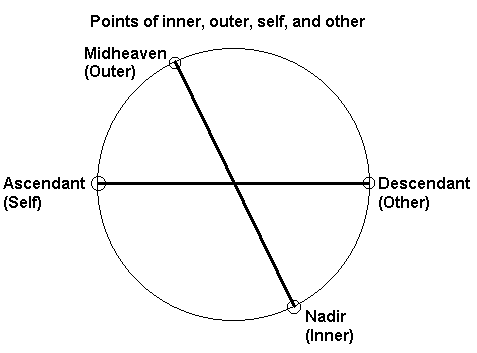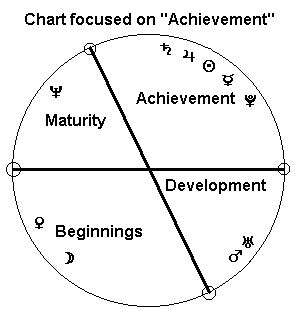ASTROLOGY WEEKLY
Inner, Outer, Self, and Other Combined
Astrology Lesson 3 - Basic Chart Interpretation
by Tim Wilson
guest writer
After a person understands both the basic inner/outer focus of the chart and the self/other focuses of the chart, the next step is to combine this understanding to gain an understanding of the chart as a whole.

Notice that by combining all the information, there are four points on the chart where the behaviors mentioned previously are most evident in a chart. The point marked Imum Coeli (commonly called the IC) is the farthest from the outer (upper) portion of the chart while still remaining evenly balanced between the self (left-hand side) and other (right-hand side) portions of the chart, and the point marked Midheaven (sometimes referred to as MH or MC in a chart) is the farthest from the inner (lower) portion of the chart while still remaining evenly balanced between the self (left-hand side) and other (right-hand side) portions of the chart.
Similarly the point marked Ascendant (sometimes referred to as ASC or AC in a chart) is the farthest from the other (right-hand side) portion of the chart while still remaining evenly balanced between the inner (lower) and outer (upper) portions of the chart, and the point marked Descendant (sometimes called DC in a chart) is the farthest from the self (left-hand side) portion of the chart while still remaining evenly balanced between the inner (lower) and outer (upper) portions of the chart.

As a result the IC indicates the inner (world), the Midheaven indictates the outer (world), the Ascendant is an indicator of the self, and the Descendant is an indicator of other (people) in an astrological chart.

Following these four points around the chart, beginning from the part on the above chart marked "Ascendant," there is a movement from "self" to "inner" to "other" to "outer" and back to "self." This movement from a self focus to an outer world focus and back again to a self is symbolic of a person's developmental stages.
The first stage is the "Beginnings" stage, when a new-born person begins to move from a "self" focus to a "inner" focus. This stage is when a person is just born and beginning to discover themselves and their own effect on the world (through crying, laughing, staring, etc.) As they try to learn about themselves they develop an intense focus about finding out about their own inner feelings.
After these inner feelings are understood, they begin to examine how the outside world affects them personally. This is indicated by a movement from an "inner" focus to an "other" focus. During this "Development" stage they are developing who they will be and trying out their interactions with others to see what actions gets them what they want and what actions need to be changed so they will get them what they want.
After the inner world has been fully explored in this way, it is time to begin the next stage of life, when the person takes their new-found knowledge of how to interact with others and begins to apply them to meet others needs. This "Achievement" stage marks the beginning of an awareness in the importance of a person's helping others to get what they want. It is indicated by a movement from an "other" focus to an "outer" focus as the person uses their personal understanding of other people to better understand the needs and motivations from the other person's point of view. As these other-focused skills are learned the person moves farther away from simply satisfying their own needs and increasingly focuses on helping other people solve their problems.
Finally, the person has achieved the goals of the others in their life and begins to look for ways to combine their knowledge of the outer world with their own need to help the outer world. This begins the final stage, the "Maturity" stage, in which they apply and use the lessons learned in the outer world. This is indicated by a movement from an "outer" focus to a return to a "self" focus.

If a majority of a person's pictures are located in one of these four sections Beginnings, Development, Achievement, or Maturity, it indicates that the person is focused on one of these four developmental stages. For example, in the chart above, more of the pictures are focused in the first section, "Beginnings" than in the other three sections. This person focuses most on developing themself personally, without depending on others to assist.

In this chart, more of the pictures are focused in the second section, "Development" than in the other three sections. This person focuses most on developing their personal relations with others, and are dependent on others to assist them achieve the chart owner's goals.

In this chart, more of the pictures are focused in the third section, "Achievement" than in the other three sections. This person focuses most on developing an awareness of interrelating with other people based on what the other person wants from them, and tries to help others get what they want.

In this chart, more of the pictures are focused in the fourth section, "Maturity" than in the other three sections. This person focuses most on using their understanding of the outer world to personally achieve goals which help the outer world.
>>> Proceed to the Next Lesson>>> Return to the Previous Lesson
<<< Go to the Introductory Page
